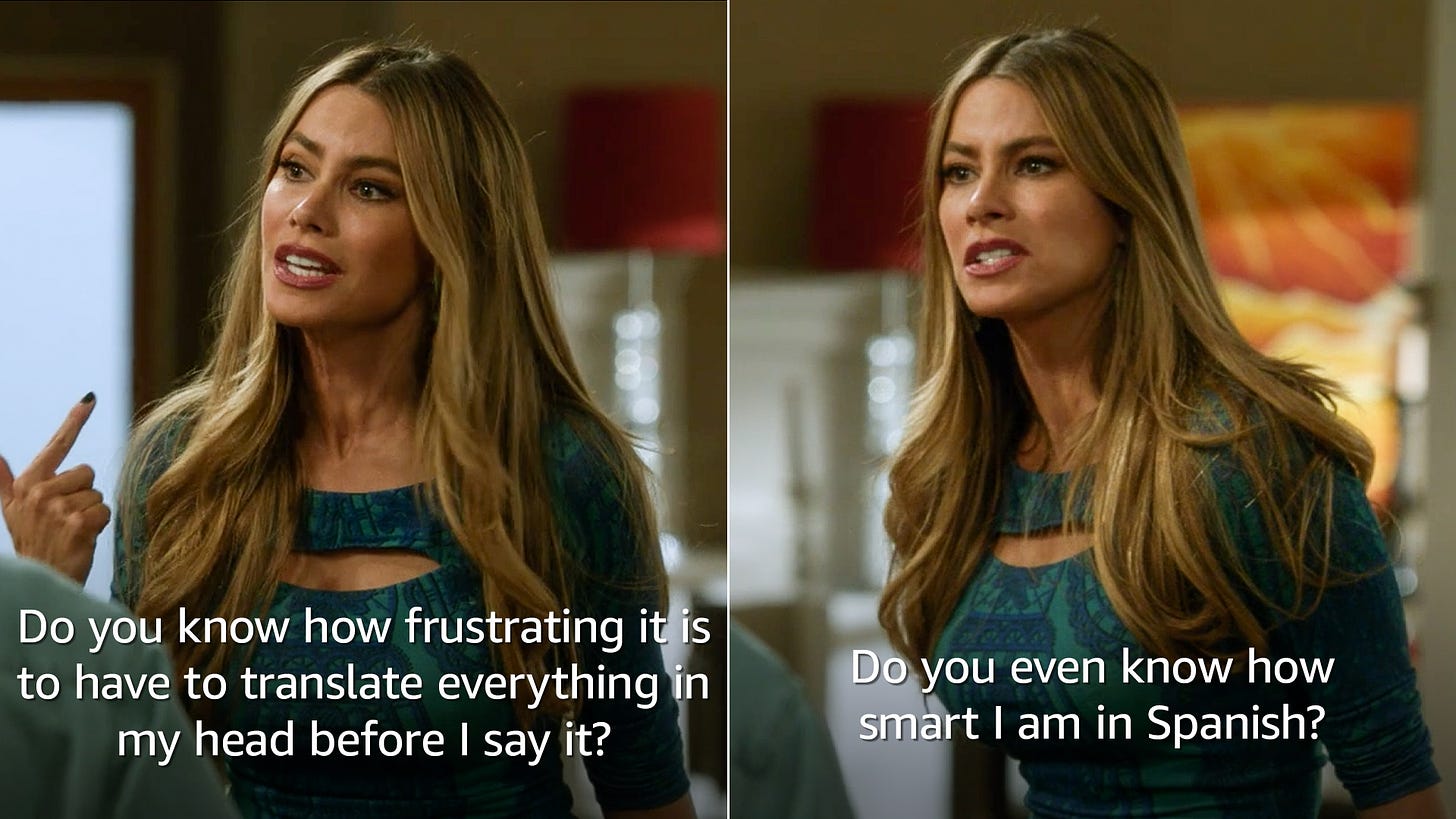How to Become the Smartest Person in Any Room
Using Open-Ended Questions to Take Control of Any Conversation or Negotiation
Whether many of you believe it or not, I can say from speaking with you all that there is no doubt when we are speaking you are the smartest person in the room. However, you come to me for help to be more expressive in your non-native language of English. If it weren’t for this barrier you face of having to speak English, we wouldn’t be speaking at all.
Thinking of this concept reminds me of these lines from Sofia Vergara in the show Modern Family.
I can feel your pain as I feel this pain when speaking Spanish. The feeling of being stuck in a conversation or not being able to express myself as I’m able to in English is one of the worst feelings there is. Having to process everything in your brain, think of the different ways you can say something, and then decide which way is best all in real time is very difficult.
So today I’m going to give you a tool that will allow for you to become the smartest person in the room while speaking English.
I will preface that all of this advice comes directly from former FBI negotiator Chris Voss’ book Never Split the Difference - Negotiation as if Your Life Depends on It. This book has taught me many extremely valuable lessons, and is known as the bible for negotiation. If you haven’t already read it, I highly recommend it. If you have, I suggest reading it again ;)
How to Use Tactical, Calibrated Open-Ended Questions to Buy Time and Take Control
A tactical, calibrated open-ended question always begins with ‘how’ or ‘what’, and always avoids using ‘why'. When we ask a question such as “why did you do that?” we must understand that ‘why’ questions are directly challenging our counterpart. Also understanding that we are trying to reason with someone’s irrational, animal brain (emotional brain), we should realize that we will trigger an emotional response, such as ‘because’ or ‘I don’t know.’
Neither of these responses gives us any additional information from our counterpart to help us move forward in navigating the conversation. The more information that we have, the more we can process a situation and steer it in the direction that we want it to move in.
Asking open-ended questions using ‘what’ and ‘how’, such as ‘what caused you to do this?’ or ‘how can we use this to make this better?’ force your counterpart to stop and think. The beauty in this is that there are no fixed answers to these questions.
As a non-native speaker taking part in a mostly unplanned conversation, piecing together a fluent response is generally the biggest challenge that we all face. Every second that we take to pause and think before responding causes us to feel less confident as we feel like our counterpart assumes we don’t know what we are talking about.
When we force them to pause and think to formulate an open-ended answer, we have just bought ourselves more time to formulate a more coherent response. This is the first benefit that using open-ended questions gives us.
The second benefit of asking open-ended questions is that we give our counterpart the illusion of control in the conversation or negotiation. When they are formulating a response to your question, their response to them feels as if they are now steering the ship. But in fact, you are gaining deeper insight to their thought process which will allow for you to ultimately steer the conversation.
This is extremely powerful because now you are able to better understand their thought process. As a non-native speaker you can tactically ask these ‘how’ and ‘what’ questions in order to gain clarity when your counterpart used a word or phrase that you didn’t fully understand.
Let’s create a real life scenario and example of how you can use a label and an open-ended question in order to get clarification.
Scenario: You are working with a cross-functional teammate on a project. During a meeting there is a problem that you two don’t see eye-to-eye on.
Goal: Understand why your colleague doesn’t think your solution is the best solution.
Colleague: Your proposed solution (y) to this issue won’t work. We should do x instead of y.
You: Why won’t y work?
Colleague: Because it’s a bad idea.
Oof. Do we see how easy it is to respond with a close-ended response when we are in a situation that is potentially heated? Let’s instead use an open-ended question.
Colleague: Your proposed solution (y) to this issue won’t work. We should do x instead of y.
You: What do you think the main issues are with this solution?
Colleague: (loading ideas)...well, I think that x could be done this way instead, y could be okay but if x isn’t made better then y won’t work, and z is actually not a bad implementation.
Do you see the difference? You just gained insight into how they are thinking, bought yourself time to formulate a response, and took complete control of the conversation.
There are some other important aspects of using open-ended questions that we will dive into in the future, but for now, do your best to replace all closed-ended questions with open-ended ones. It may feel a little weird at first, and will certainly take practice, but I promise you that you will see a huge difference!
If you found this helpful, please give it a share!



